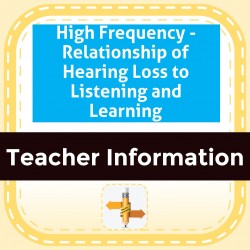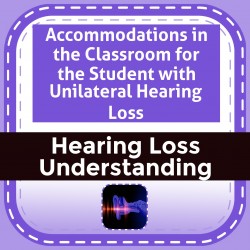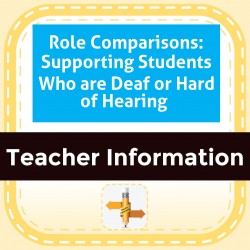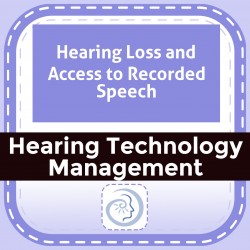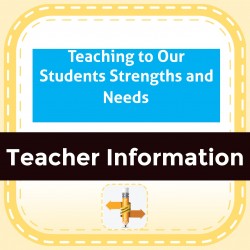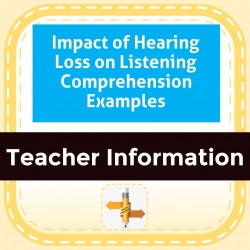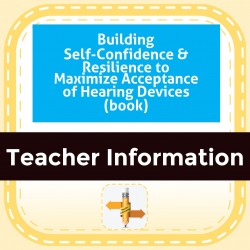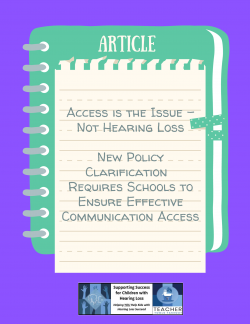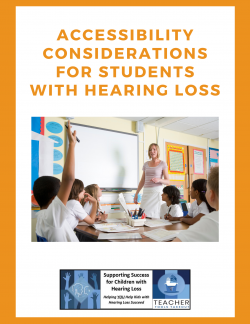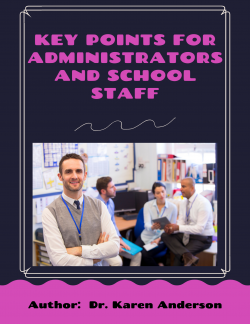Ability Levels
Categories
Resource Types
Age/Grade Range
CCSS
Anchor Standard
Speaking & Listening
Language
Reading
High Frequency - Relationship of Hearing Loss to Listening and Learning
$ 0
Handout with information on possible impact on understanding language, speECH-, social, and need for educational accommodations and services. For high-frequency hearing loss.
Accommodations in the Classroom for the Student with Unilateral Hearing Loss
$ 0
This one-page handout for DHH professionals describes information to be shared with classroom teachers who have students with unilateral hearing loss.
Role Comparisons: Supporting Students Who are Deaf or Hard of Hearing
$ 0
Handout designed to support discussion by school teams regarding the role of the teacher of the deaf/hard of hearing, educational audiologist, speECH- language pathologist, special educator, and sign
...
language interpreter in providing support and services to students with hearing loss. Includes possible issues that need to be considered specific to hearing loss.
Hearing Loss and Access to Recorded Speech
$ 195
An increasing number of educational resources are being delivered through recorded speech in the younger grades, listening centers, and test examinations. This article focuses on the reasons why recor
...
ded speech are so challenging for students who are hard of hearing thus necessitating a live voice reader in many situations.
Teaching to Our Students Strengths and Needs
$ 195
This article summarizes recent research regarding the language and cognitive differences between students who are DHH and their hearing peers. Identification of these differences can help professional
...
s better understand classroom challenges faced by our students and strategies to support students through these challenges.
Impact of Hearing Loss on Listening Comprehension Examples
$ 0
Teacher inservice handout to use to help make sense of Functional Listening Evaluation (FLE) results. Represents instructions in written form overlaid on puzzle pieces. DHH specialist would black out
...
word endings and phonemes to respresent reduction in speECH- perception based on percent response on FLE.
Building Self-Confidence & Resilience to Maximize Acceptance of Hearing Devices (book)
$ 14
A significant proportion of students with hearing loss refuse to use hearing technology necessary for their educational access, often because they feel as though they do not fit in to their peer group
...
. The purpose of this book is to raise awareness for the reasons why hearing device rejection happens and specific instruction to occur at different ages to build student resilience and self-‐confidence, thereby increasing the likelihood that they will not reject using their hearing technology. Specific teaching activities and recommendations for instructional materials to develop identified skills have been included in this Guide.
Article: Access is the Issue, Not Hearing Loss - New Policy Clarification Requires Schools to Ensure Effective Communication Access
$ 0
Information in this article is presented to assist the educational audiologist, teacher of the deaf/hard of hearing, or speECH--language pathologist in demonstrating the impact of hearing loss on acce
...
ss to classroom communication so that the ADA question “Does this student have effective access to communication in school?” can be answered in an evidence-based manner. By Karen Anderson.
Accessibility Considerations for Students with Hearing Loss
$ 0
Communication access is a key component of 504, IDEA and Title II of the ADA. Under Title II of the ADA, schools are required to ensure that communication access is as effective for children with hear
...
ing loss as it is for their typically hearing peers through the provision of appropriate auxiliary aids and services. This handout provides examples of auxiliary aids and services that can make aurally delivered information available to students with hearing disabilities so that they can receive information from, and convey information to, others as effectively as students without disabilities.
Key Points for Administrators and School Staff
$ 095
This resource discusses key point for administrators and school staff regarding the educational needs of students with hearing loss in regard to the realities of hearing device use and what educators
...
can do, including extra knowledge and skills, daily classroom needs, and social interaction issues. Separate handouts for teachers of students in early elementary and those in upper elementary and secondary grades. The information also includes evidence-based decision-making for access accommodations for students with hearing loss which focuses on the requirements of Title II of the ADA and the school's responsibility to identify appropriate communication access accommodations for every situation encountered in school. Worksheet to be used for team discussion of access needs is included.
 Your browser is out of date. For best experience switch to latest updated Browser.
Your browser is out of date. For best experience switch to latest updated Browser.
 Get Chrome
Get Chrome Get Edge
Get Edge Get Firefox
Get Firefox